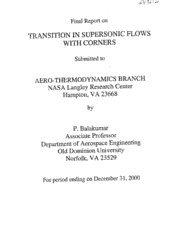
NASA Technical Reports Server (NTRS) 20010108003: Transition In Supersonic Flows With Corners PDF
Preview NASA Technical Reports Server (NTRS) 20010108003: Transition In Supersonic Flows With Corners
._ 7_-__ Final Report on TRANSITION IN SUPERSONIC FLOWS WITH CORNERS Submitted to AERO-THERMODYNAMICS BRANCH NASA Langley Research Center Hampton, VA 23668 by P. Balakumar Associate Professor Department of Aerospace Engineering Old Dominion University Norfolk, VA 23529 For period ending on December 31, 2000 ABSTRACT It is proposed to investigate the effect of sudden change in the slope of the surface on the stability and transition onset point in supersonic and hypersonic boundary layers. Since we can not use the linear stability theory in flows where there are discontinuities we have to solve the full Navier-Stokes equations to determine the amplification of the disturbances across the oblique shock which exists at the comer. We will use the Navier-Stokes code which was developed by Dr. Harold Atkins in the aerodynamic and acoustic methods branch. The code is developed using the higher order ENO scheme and is currently set up for two-dimensional flows. In the first year of our investigation, we will investigate the evolution of small amplitude two-dimensional disturbances and determine the N-factors for the most amplified disturbances. We will perform the analysis for the parameter similar to X-31 model and flight experiment conditions. From these computation we will infer what is the maximum amplification rate possible in quite environments without any tripping devices. In the second part of the investigation, we will perform nonlinear computations to determine what is the minimum amplitudes necessary to cause the transition at a designed location. In the third part, we have to determine what kind of trip devices necessary to excite the required disturbances. The principal investigator of this project is Dr. P. Balakumar, Associate Professor of Department of Aerospace Engineering, Old Dominion University. We will actively collaborate with research scientists in the Aero-Thermodynamics Branch at NASA/Langley Research Center. A half-time graduate student will also participate in the project. 1. MOTIVATION 1.1 Introduction The transition process in incompressible and compressible fiat-plate and axisymmetric boundary layers can be easily analyzed using linear stability and PSE methods. The transition onset point can be predicted using the N-factor method. In boundary layer flows with discontinuities, the linear stability theory and the PSE method cease to be valid and we have to solve the full Navier-Stokes equations to find the evolution of the disturbances. The motivation of this work is todeterminethe flow conditionsin front of theinlet to the propulsionsystem in theX-31 flight vehiclein the flight conditionswithout any tripping devices andalsoto determinewhat is theefficientway tocausethetransitionbeforethe inlet. This investigationalso will improve our understandingof the effectsof comershockswhich exist in mostof the hypersonicandsupersonicvehicleson the transitiononsetpoint. In this work wewill investigatethestability andthetransitiononsetpoint in thesupersonicandhypersonicflows overwedgeshapedgeometriesasshownin figure I. In the flat regionsAB andBC classicallinearstability theoryandthe PSEmethodcanbeapplied. The evolutionof the disturbanceacrossthe corner canonly bedeterminedby solving thefull Navier-Stokesequations. The solution of thefull Navier-Stokesequationsto determinethe evolution of theinstability wavesrequireshigherorderaccuratenumericalscheme.In this problemwealsohavetocapturetheobliqueshockanditsoscillationsaccurately. Wewill employthehigherorderaccurateENO schemeandhigherorderRunke- Kutta time marching scheme in the computations. 1.2 Objectives The objective of this investigation is to determine the evolution of the linear disturbances and the N-factors for the most amplified disturbances in supersonic and hypersonic flow over wedge shaped geometries. The second objective is to perform nonlinear computations to determine what is the minimum amplitudes necessary to cause transition at a designated location. The third objective is to identify efficient tripping devices which will generate these disturbances with minimum drag force. 2. DESCRIPTION OF PROPOSED COMPUTATIONS We will solve the full unsteady Navier-Stokes equations to determine the N- factors for the most amplified disturbances for supersonic and hypersonic flows over wedge shaped geometries as shown in figure 1. We will use higher order ENO scheme to compute the spatial derivatives and use the Runge-Kutta time integration method to compute the time accurate solution. We will first solve for the steady solution over the prescribed geometry and then perturb the flow at an initial location (figure 2) to study the evolution of disturbances downstream. Wewill performthe computationsfor theparameterssimilar to X-31 modeland flight experimentconditions. Mostof thecomputationswill bedoneon theSGI machinesavailablein the Departmentof AerospaceEngineeringatOld Dominion University. 3. TIME PERIOD AND GOALS In the first year, we will investigate the evolution of small amplitudes two- dimensional disturbances and determine the N-factors for the most amplified disturbances. The goal is to find what is the maximum amplification possible in quiet environments without any tripping devices. In the second year, we will perform nonlinear computations to determine what is the minimum amplitudes necessary to cause the transition at a designated location. 4. PERSONNEL The principal investigator of this project is Dr. P. Balakumar, Associate Professor of Department of Aerospace Engineering, Old Dominion University. We will actively collaborate with research scientists in the Aero-Thermodynamics Branch at NASA/Langley Research Center. A half-time graduate student will also participate in the project.
